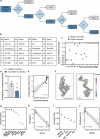Comparative optimization of polysaccharide-based nanoformulations for cardiac RNAi therapy
- PMID: 38926348
- PMCID: PMC11208445
- DOI: 10.1038/s41467-024-49804-x
Comparative optimization of polysaccharide-based nanoformulations for cardiac RNAi therapy
Abstract
Ionotropic gelation is widely used to fabricate targeting nanoparticles (NPs) with polysaccharides, leveraging their recognition by specific lectins. Despite the fabrication scheme simply involves self-assembly of differently charged components in a straightforward manner, the identification of a potent combinatory formulation is usually limited by structural diversity in compound collections and trivial screen process, imposing crucial challenges for efficient formulation design and optimization. Herein, we report a diversity-oriented combinatory formulation screen scheme to identify potent gene delivery cargo in the context of precision cardiac therapy. Distinct categories of cationic compounds are tested to construct RNA delivery system with an ionic polysaccharide framework, utilizing a high-throughput microfluidics workstation coupled with streamlined NPs characterization system in an automatic, step-wise manner. Sequential computational aided interpretation provides insights in formulation optimization in a broader scenario, highlighting the usefulness of compound library diversity. As a result, the out-of-bag NPs, termed as GluCARDIA NPs, are utilized for loading therapeutic RNA to ameliorate cardiac reperfusion damages and promote the long-term prognosis. Overall, this work presents a generalizable formulation design strategy for polysaccharides, offering design principles for combinatory formulation screen and insights for efficient formulation identification and optimization.
© 2024. The Author(s).
Conflict of interest statement
D.P. receives licensing fees (to patents on which he was an inventor), has invested, has consulted, has been on the scientific advisory boards or boards of directors, given paid lectures or conducted research at Tel Aviv University sponsored by ART Biosciences, BioNTech SE, Earli, Kernal Biologics, Geneditor Biologics, Merck, NeoVac, Newphase, Roche, SirTLabs Corporation and Teva Pharmaceuticals. All other authors declare no competing interests.
Figures







References
Publication types
MeSH terms
Substances
Grants and funding
LinkOut - more resources
Full Text Sources
Research Materials

